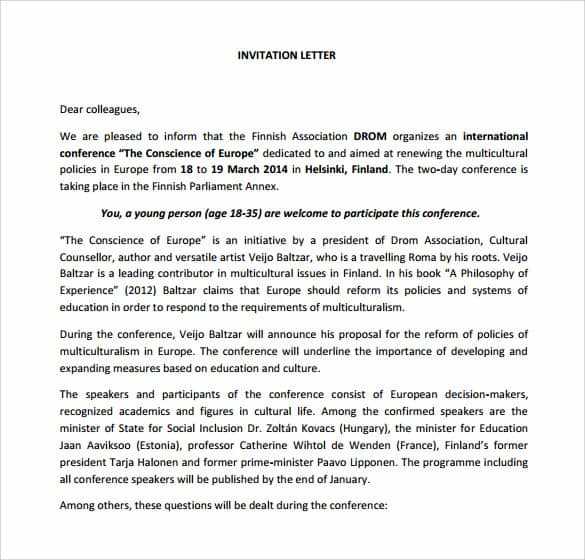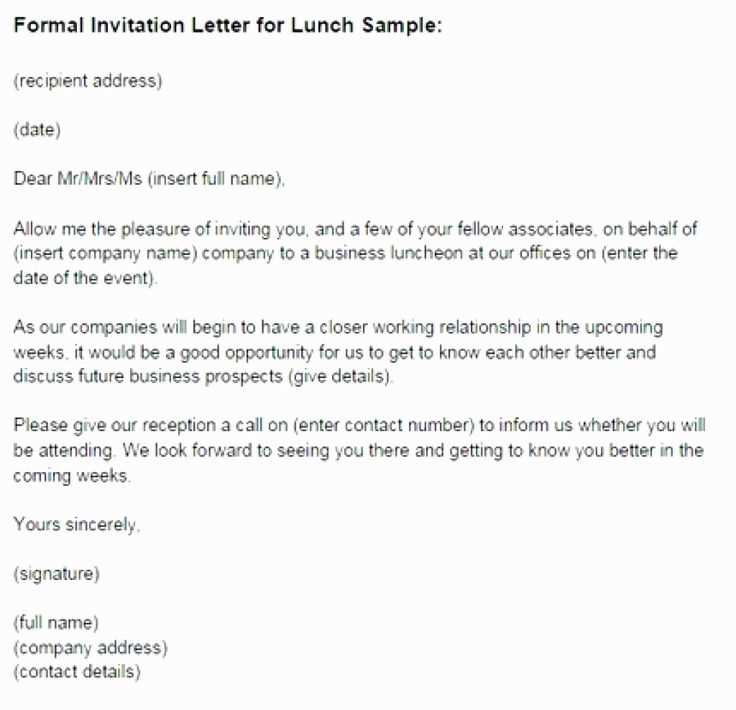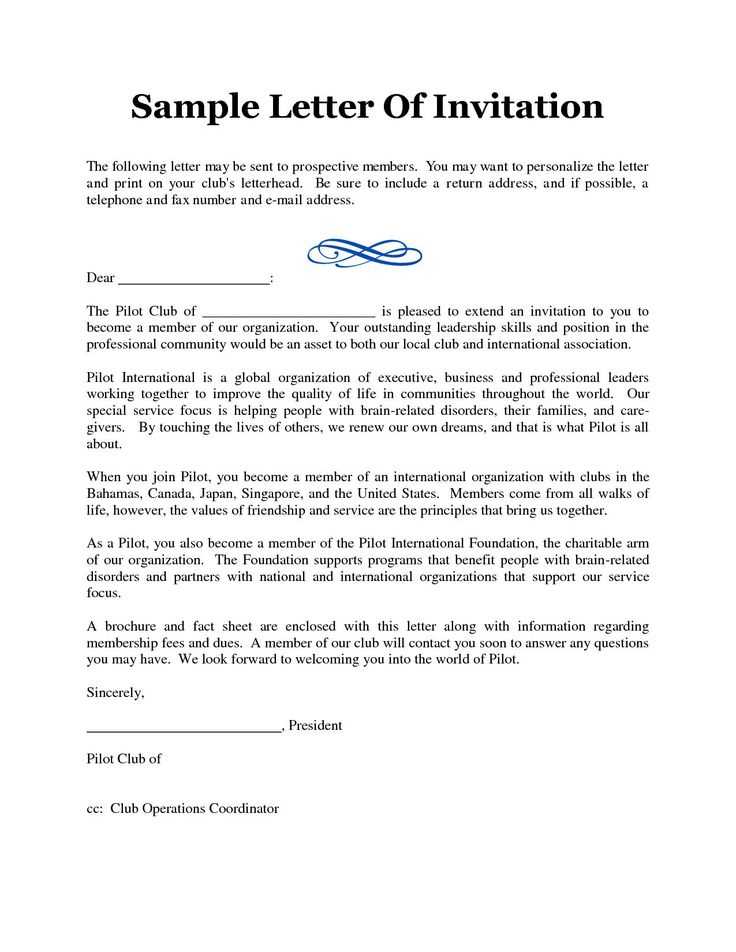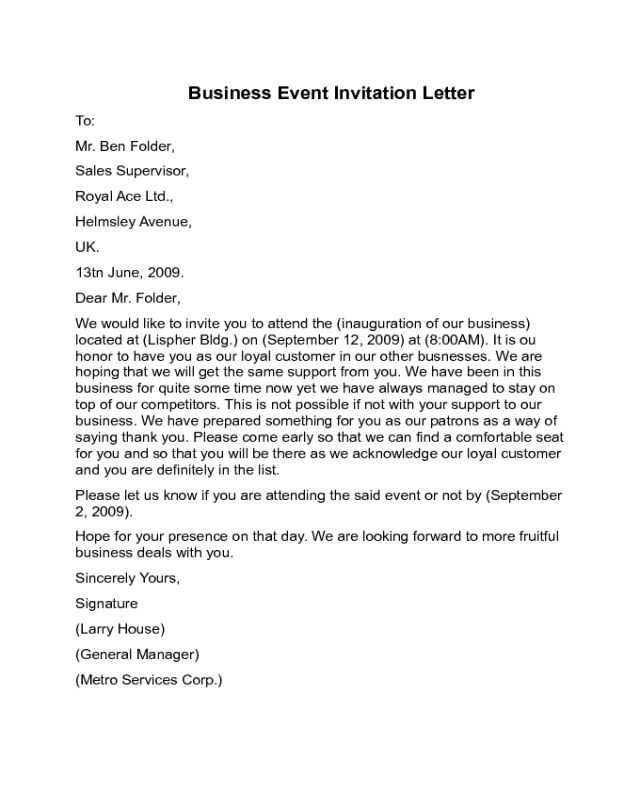Formal event invitation letter template

A formal event invitation letter must convey all the key details in a professional yet welcoming manner. Focus on clarity and precision. Start by specifying the type of event, the date, time, and location. This avoids any confusion and sets the tone for your event.
Next, mention the purpose of the event, whether it’s a conference, ceremony, or meeting. This helps the recipient understand the context and prepare accordingly. Always include a polite request for their presence to make the invitation feel personal.
End the letter with clear instructions on how to RSVP, including the deadline. If there are any special instructions, such as dress code or documents to bring, make sure to highlight them. Keep the tone professional yet warm to ensure your guests feel valued and informed.
Here are the corrected lines:
When drafting a formal event invitation letter, focus on clarity and respect. Use a direct and respectful tone, ensuring that the purpose and details are easy to understand. Below are the necessary corrections:
Before:
| Original Text | Correction |
|---|---|
| We would like to invite you to our event on the date of… | You are cordially invited to attend our event on… |
| We hope that you can make it to the event. | We look forward to your presence at the event. |
| It will be held in the place of your choosing. | The event will take place at [venue name and address]. |
| Don’t hesitate to RSVP. | Please confirm your attendance by [RSVP date]. |
Explanation:
The first sentence is more formal and specific. It sets a clear, respectful tone, inviting the recipient directly. The second revision makes the expectation of attendance more evident, using “look forward” rather than “hope.” The third revision ensures that venue details are included, as this is essential information for any formal invitation. The final correction provides a specific date for RSVP, offering a clear call to action. These changes streamline the invitation, making it polite and direct.
- Formal Event Invitation Letter Template
A formal event invitation letter should be clear and concise, ensuring that the recipient understands the purpose of the event, as well as the necessary details. It is important to strike the right tone–professional, yet warm enough to encourage attendance. Below is a simple structure that you can follow when creating an invitation letter for your formal event:
Key Elements of the Invitation Letter
- Event Name and Purpose: Start by clearly stating the event’s name and its purpose. For example, “You are cordially invited to the Annual Charity Gala to support local community programs.”
- Event Details: Include the date, time, location, and any important instructions regarding attire or special preparations. “The event will take place on March 15th, 2025, from 7:00 PM at the Grand Hall, City Center.”
- RSVP Information: Indicate the deadline for responses and any specific instructions regarding how to confirm attendance. “Please RSVP by March 5th, 2025, by emailing your response to [email protected].”
- Personalized Greeting: Ensure that you address the recipient appropriately, especially in formal settings. “Dear Mr. John Smith,” is a common, respectful salutation.
- Closing Remarks: End with a note of anticipation or appreciation. “We look forward to your presence at this special event.”
Example Template

Here’s an example template based on the structure mentioned above:
Dear [Recipient's Name], You are cordially invited to the [Event Name] to celebrate [Event Purpose]. The event will be held on [Date] at [Time] at [Location]. Please RSVP by [RSVP Deadline] by contacting us at [RSVP Contact Information]. We would be delighted to have you join us for this occasion. Sincerely, [Your Name] [Your Position/Organization]
This simple format allows you to keep the invitation professional while providing all necessary details for the recipient to decide whether to attend the event.
Begin by using a proper salutation that reflects the formality of the event and the recipient’s status. If you’re addressing a person with a title, such as “Dr.” or “Professor,” include this in the greeting. For example, “Dear Dr. Smith” or “Dear Professor Johnson” is both respectful and professional. When unsure of the recipient’s title, use “Mr.” or “Ms.” followed by their last name, ensuring neutrality and respect.
Gender-Neutral Addressing
If you are uncertain about the recipient’s gender or prefer to avoid gendered language, use their full name or a neutral salutation like “Dear [First Name] [Last Name].” This approach is courteous and avoids making assumptions.
Using Formal Titles
When addressing someone of high rank or position, such as a CEO or a government official, make sure to include their formal title. For instance, “Dear Mayor Thompson” or “Dear CEO Williams” demonstrates respect for their position. Always double-check the correct title, as using an incorrect one could appear unprofessional.
Match the tone of your invitation to the event’s formality level. For formal events, use professional language and maintain a respectful tone throughout. Avoid slang, contractions, and overly casual expressions. Ensure the invitation feels polished and reflects the seriousness of the occasion.
Clarity is key. Use straightforward language and ensure the message is easy to understand. Keep sentences concise and avoid unnecessary jargon. The goal is to convey all essential details while making it easy for the recipient to grasp the purpose of the event.
When addressing the guests, maintain politeness and warmth. Phrases such as “It would be our honor to have you attend” or “We would be delighted if you could join us” create a respectful and welcoming tone without being overly familiar.
Consider the recipient’s relationship to the event. If the invite is for a business gathering, use a formal and professional tone. For more intimate events, such as a gala or charity dinner, you can adopt a slightly warmer tone, but still keep it dignified.
Check for consistency in the language used throughout the invitation. Keep the same level of formality from start to finish to avoid any confusion or mixed signals.
Begin with the basics: include the date, time, and location. Make these elements easy to find and understand at a glance. Avoid long paragraphs for these details; instead, break them into simple, clean lines. For example:
Date: March 10, 2025
Time: 7:00 PM
Venue: The Grand Hall, 123 Main Street
Next, provide a brief event description to set expectations. Mention the purpose of the event, such as a gala, award ceremony, or business meeting. Keep it concise but clear to avoid confusion.
If there are any specific instructions, such as dress codes or RSVP requirements, highlight them separately. Use bullet points or separate lines for these to keep the information easily digestible:
- Dress Code: Black tie
- RSVP: Please respond by March 1, 2025
- Parking: Available at the venue
Consider including the contact information for any questions, and specify the best way to reach someone. This ensures clarity in case the invitee needs assistance or more information.
Lastly, finish with a polite closing line, encouraging the invitee’s participation and looking forward to their presence at the event.
Specifying RSVP Instructions Professionally
Clearly stating RSVP instructions ensures you receive the necessary confirmations for your event. Be direct and specific, providing all the details your guests need to respond effectively.
Be Clear with the RSVP Deadline
Indicate the exact date by which you need responses. This helps your planning and avoids confusion. For example, “Please confirm your attendance by [Date].” Always make it a date that gives you enough time to make final arrangements.
Provide Multiple RSVP Methods
Offer guests several ways to respond. This could include email, phone calls, or a specific event website. Make sure to include clear contact information and ensure it is easily accessible. For example, “Kindly respond by email to [[email protected]] or call [Phone Number].” A streamlined process increases the likelihood of a timely response.
Additionally, if you use an online RSVP tool, provide a direct link to the site for ease. The simpler the process, the higher the chances of receiving replies on time.
Clarify Attendance Details
Ask for specific information that may affect your event planning. For example, request meal preferences or other necessary details, if applicable. A sample line could be, “Please indicate whether you will require a vegetarian meal.” This allows you to tailor your event to guests’ needs without confusion.
Set Expectations for Non-Responses
If a guest does not respond by the deadline, you may need to follow up. A polite reminder in the invitation can be helpful, such as, “If you are unable to attend, please let us know as soon as possible.” This encourages action from those who may have overlooked the RSVP request.
Sample RSVP Table
| Action | Details |
|---|---|
| RSVP Deadline | [Date] |
| Email Response | [[email protected]] |
| Phone Response | [Phone Number] |
| Special Requests | Vegetarian Meal, Accessibility Needs, etc. |
Being clear and detailed with your RSVP instructions sets a professional tone and ensures that all the necessary information is gathered to make your event successful.
List the event date and time clearly, using a precise format. For example, “March 10, 2025, at 6:00 PM GMT.” If the event spans multiple days or has different times, make sure this is indicated clearly. Specify the time zone if your audience is in different regions to avoid confusion.
For the location, provide the full address with any relevant details such as the venue name, room or floor number, and specific instructions for accessing the venue, like parking or entry points. If the event is online, include the platform name and access link or instructions on how to join. Make all logistics easy to read and direct.
Clearly communicate any additional information or requirements attendees need to know before the event. This helps avoid confusion and ensures everyone is prepared. Start with any necessary actions that need to be taken prior to the event, such as RSVP deadlines or dress codes. Include any special instructions that may apply to specific groups of attendees, such as VIPs or speakers.
Key Details to Include

- RSVP Information: Specify how attendees should confirm their attendance and the deadline for doing so. Include an email address or phone number if needed.
- Dress Code: If there is a specific dress code, mention it clearly (e.g., formal, casual, black tie). Include any special attire requirements if applicable (e.g., “wear comfortable shoes” for an outdoor event).
- Parking and Transportation: Provide information about parking availability, public transport options, or shuttle services to the venue.
- Special Requirements: Include details for any dietary preferences or accessibility needs attendees should inform you about ahead of time.
Other Considerations

- Arrival Instructions: Mention any specific instructions for entering the venue, such as check-in times or ID requirements.
- Event Schedule: Share a brief outline of the event schedule so attendees can plan their time accordingly.
- Contact Information: Provide a contact person or helpdesk in case attendees have questions or face issues before or during the event.
When writing a formal event invitation letter, structure and clarity are key. Focus on the main details that the invitee needs to know. Follow these steps for an impactful invitation:
- Start with a clear heading: Address the invitee directly, including their name and the event title. This helps set the tone and informs the recipient immediately about the purpose of the letter.
- Provide essential event details: Include the event date, time, and location. Be specific and double-check these details to avoid confusion.
- State the purpose of the event: Briefly mention the event’s goal or theme. Whether it’s a celebration, meeting, or gala, the invitee should understand why they are being invited.
- Include RSVP information: Make it easy for guests to respond. Provide a clear date and contact information for RSVPs. Specify how they can confirm attendance, whether by phone or email.
- Keep the tone professional but welcoming: While the letter should be formal, ensure the language is warm and inviting. A polite and engaging tone will make the recipient feel valued.
- Conclude with appreciation: End the letter by expressing gratitude for the recipient’s consideration and anticipation of their presence at the event.
By following these steps, you create a letter that provides all the necessary information while maintaining a professional and courteous tone.